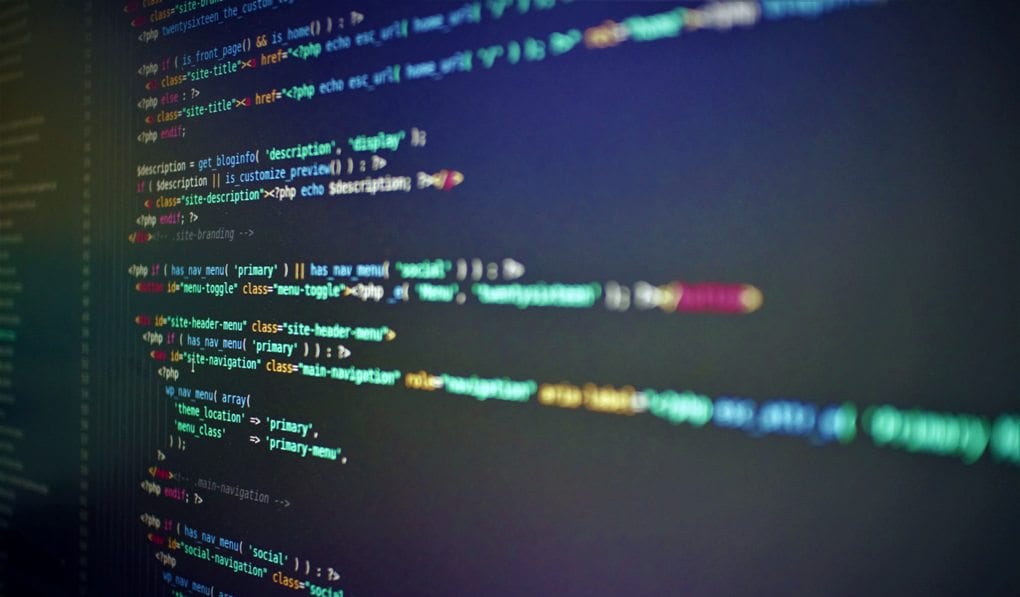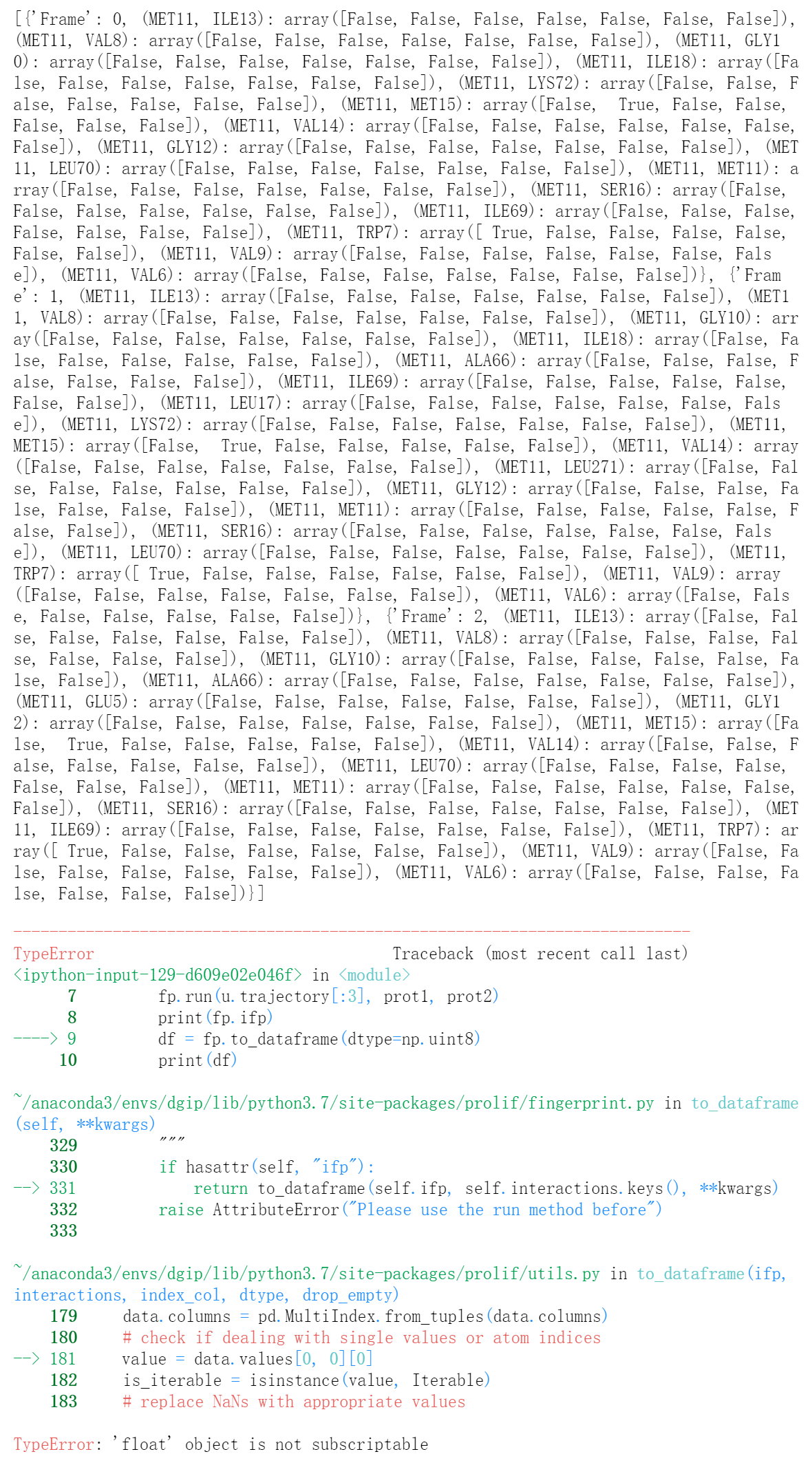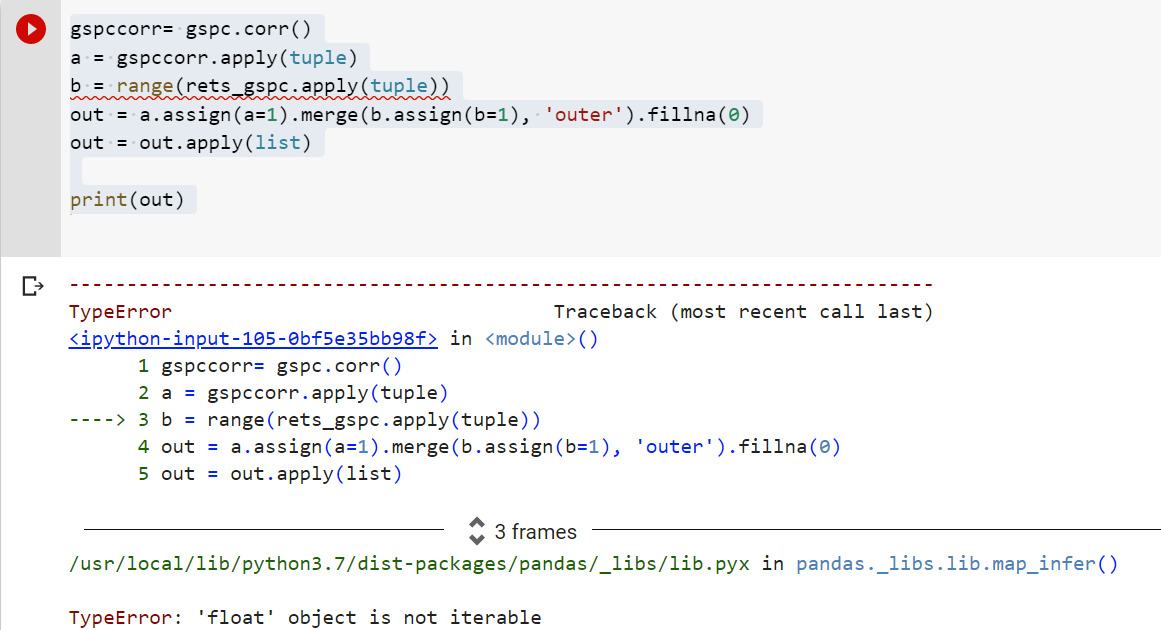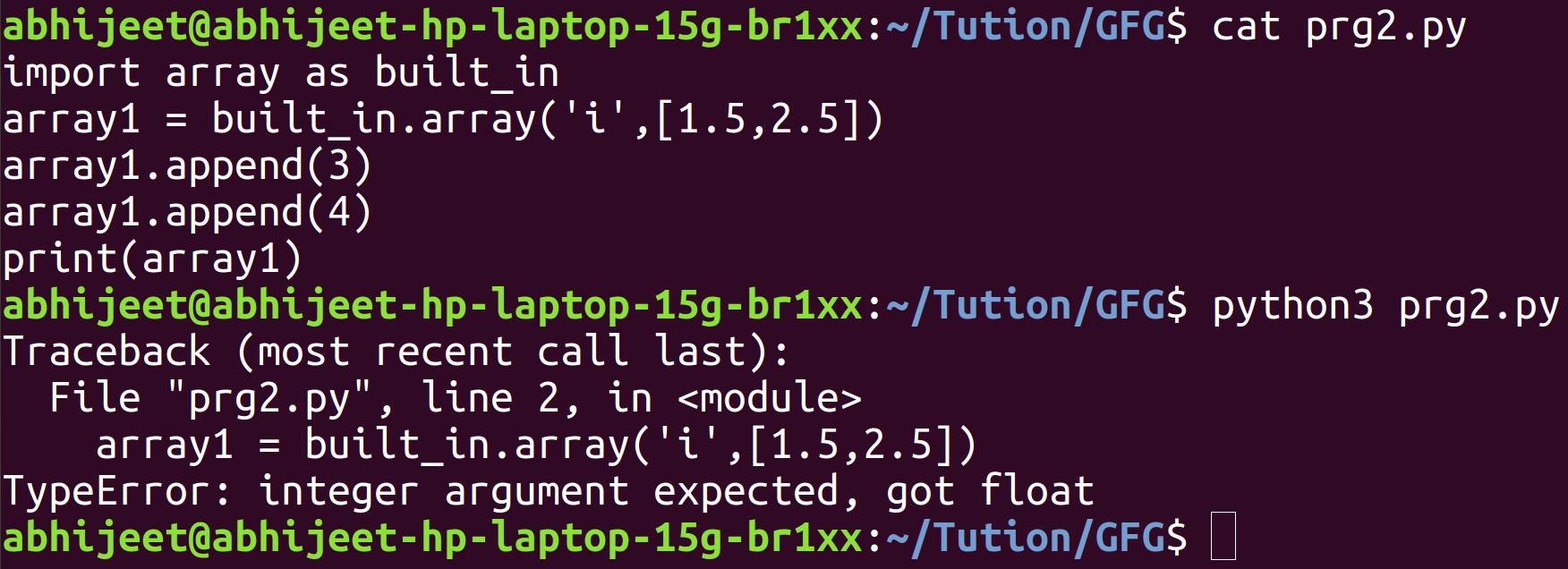Typeerror ‘Float’ Object Is Not Iterable
What is a ‘TypeError: ‘float’ object is not iterable’?
In Python, an iterable is an object that can be iterated over or looped through. It can be a sequence like a list, tuple, or string, or a collection like a dictionary or set. When you encounter the error message “TypeError: ‘float’ object is not iterable,” it means that you are trying to iterate over a float object, which is not valid since floats are not iterable.
A float object represents a numerical value with decimal points. It is a data type used to store and manipulate decimal numbers. However, unlike strings or lists, floats cannot be accessed or looped over element by element.
Causes of the ‘TypeError: ‘float’ object is not iterable’
1. Accessing individual elements of a float: Since floats are not indexable, attempting to access individual elements or iterate over them will raise this error. For example:
“`python
number = 3.14
for digit in number:
print(digit)
“`
Output:
“`
TypeError: ‘float’ object is not iterable
“`
2. Assigning a float to an iterable variable: If you mistakenly assign a float value to a variable that is expected to be an iterable, such as a list or dictionary, it will result in a ‘float’ object is not iterable error. For instance:
“`python
my_list = 5.0
for item in my_list:
print(item)
“`
Output:
“`
TypeError: ‘float’ object is not iterable
“`
Common scenarios where the ‘TypeError: ‘float’ object is not iterable’ occurs
1. Looping through the elements of an incorrect object: Trying to iterate over a float directly instead of an iterable object is a common mistake that leads to the ‘TypeError: ‘float’ object is not iterable’ error. Always ensure that you are working with an iterable when using loops.
2. Incorrect usage of functions: Certain built-in functions or methods may expect an iterable as an argument. If you mistakenly pass a float instead of an iterable object, the ‘TypeError: ‘float’ object is not iterable’ error may occur.
How to fix the ‘TypeError: ‘float’ object is not iterable’
1. Check your code for float variables used in loops: Double-check your code to ensure that you are not trying to iterate over a float object. If you want to iterate over a sequence of numbers, consider using a range or converting the float to an integer.
2. Verify the data type of the variable: When assigning a value to a variable that will be used in a loop or with a function that expects an iterable, ensure that the assigned value is indeed an iterable data type like a list or tuple.
3. Convert the float to an iterable: If you have a single float value that you want to iterate over, you can convert it into an iterable type like a list or tuple using the appropriate conversion function. For example:
“`python
number = 3.14
number_as_list = [number]
for digit in number_as_list:
print(digit)
“`
Output:
“`
3.14
“`
Example code that triggers the ‘TypeError: ‘float’ object is not iterable’
“`python
float_value = 2.718
for character in fl
# This code attempts to iterate over a float value, which causes the TypeError: ‘float’ object is not iterable
“`
Tips to avoid the ‘TypeError: ‘float’ object is not iterable’
1. Be aware of the data type you’re working with: Always ensure that you are working with iterable data types when iterating over elements or passing arguments to functions that expect an iterable.
2. Validate inputs from external sources: If you are obtaining input from external sources, such as user input or file handling, it is crucial to validate the input to ensure it matches the expected data type and format.
3. Use type-checking and conditional statements: Before performing operations or iterations, consider using conditional statements to verify the type of the variable. This can help you catch and handle non-iterable variables before they cause iteration errors.
Key takeaways
– The ‘TypeError: ‘float’ object is not iterable’ occurs when you try to iterate over a float object, which is not valid since floats are not iterable.
– Common causes of this error include attempting to loop through a float directly or incorrectly assigning a float value to an iterable variable.
– To fix the error, check your code for float variables used in loops, verify the data type of the variable, and convert the float to an iterable if necessary.
– Tips to avoid this error include being aware of the data type you’re working with, validating inputs from external sources, and using type-checking and conditional statements to handle non-iterable variables.
FAQs
Q: What does ‘float’ object is not subscriptable mean?
A: The error message ‘float’ object is not subscriptable occurs when you try to access elements of a float using indexing (e.g., float_value[0]). Floats are not subscriptable because they represent single numerical values and not a collection of items.
Q: How can I convert a float to an integer in Python?
A: You can convert a float to an integer in Python using the int() function. For example:
“`python
float_value = 3.7
int_value = int(float_value)
print(int_value)
“`
Output:
“`
3
“`
Q: How do I convert a list of floats to integers in Python?
A: To convert a list of floats to integers in Python, you can use a list comprehension or the map() function. Here’s an example using a list comprehension:
“`python
float_list = [3.14, 2.718, 1.618]
int_list = [int(float_item) for float_item in float_list]
print(int_list)
“`
Output:
“`
[3, 2, 1]
“`
Q: Can I append a float to a list in Python?
A: Yes, you can append a float to a list in Python. Lists can contain elements of different data types, including floats. To append a float to a list, you can use the append() method of the list. For example:
“`python
my_list = [1, 2, 3]
my_list.append(3.14)
print(my_list)
“`
Output:
“`
[1, 2, 3, 3.14]
“`
Q: How can I convert a list to a float in Python?
A: To convert a list with a single numerical value to a float in Python, you can use the float() function. For example:
“`python
my_list = [3.14]
float_value = float(my_list[0])
print(float_value)
“`
Output:
“`
3.14
“`
Remember to handle any exceptions or edge cases that may arise when converting between different data types.
Python Typeerror: ‘Float’ Object Is Not Iterable
Why Is Float Not Iterable?
In the realm of programming, the term “iterable” refers to an object that can be looped over or traversed, allowing individual elements within it to be accessed sequentially. Python, as a versatile and popular programming language, supports many iterable data types, such as lists, tuples, and strings. However, one notable exception to this rule is the float data type, which is not iterable. In this article, we will explore the reasons behind this behavior and delve into the intricacies of the float data type in Python.
Understanding the float data type:
Before we discuss why a float is not iterable, it is important to understand what a float actually is. In Python, a float is a numerical data type used to represent decimal numbers. It is often used in mathematical calculations and operations involving non-integer values. Floats are stored as binary fractions using the computer’s native floating-point representation, allowing for a wide range of values to be expressed with a relatively small number of bits.
Why is a float not iterable?
The core reason behind the float data type not being iterable in Python lies in the fundamental differences between floats and other iterable data types like lists or strings. Floats are essentially single values representing decimal numbers, whereas iterable data types consist of multiple elements that can be accessed individually. Attempting to iterate over a float would not make sense as there is nothing to iterate over apart from the single value it holds.
Furthermore, iteration often involves incrementing or decrementing by a fixed step size, allowing for traversal through multiple items. However, floating-point numbers are continuous and infinite in nature due to the infinite nature of the real number line. Trying to iterate over an infinite range is impractical and thus, not supported by the Python language.
While it may seem limiting at first glance, the decision to make floats not iterable aligns with the concept of keeping the programming language consistent and predictable. By treating floats as a single entity, it ensures that operations and calculations involving floats are performed reliably without any unexpected behaviors.
Workarounds for iterating over float values:
Although floats themselves are not iterable, there are ways to utilize them within iterable data structures. For instance, a float value can be added as an element within a list or a tuple, which can then be iterated over. Similarly, a string representation of the float can be used, allowing for iteration over individual characters, although it may not provide the desired numerical precision.
Another approach is to convert the float to an integer if the situation permits. Integers are iterable, and converting a float to an integer discards the decimal portion, allowing the resulting integer to be iterated over.
Additionally, libraries such as NumPy offer functionalities to create arrays or matrices of float values, which can be iterated over using specialized methods designed specifically for numerical operations.
FAQs:
Q: Can I use a float in a for loop?
A: No, a float cannot be directly used in a for loop. However, you can include a float within an iterable data structure like a list or a tuple, and then use the for loop to iterate over its elements.
Q: Why can’t I iterate over individual decimal places of a float?
A: Since floats are not iterable, you cannot access individual decimal places directly. Instead, you would need to convert the float to a string representation and then iterate over the characters within the string.
Q: Can I convert a float to an integer and iterate over it?
A: Yes, converting a float to an integer using the int() function discards the decimal portion and results in an integer value that can be iterated over.
Q: Are there any drawbacks to converting a float to an integer for iteration purposes?
A: Converting a float to an integer may result in a loss of precision, as the decimal portion is truncated. Additionally, keep in mind that converting a very large or very small float to an integer may lead to overflow or underflow errors.
In conclusion, the decision to make a float not iterable in Python stems from the fundamental differences between floats and other iterable data types. While it may limit direct iteration over float values, there are workarounds available that involve utilizing floats within iterable data structures or converting them to integers. These approaches ensure the consistent and predictable behavior of calculations and operations involving floating-point numbers.
Are Float Objects Iterable?
When working with Python, it is helpful to understand how different data types behave, especially when it comes to iterating over them. In this article, we will delve into the topic of float objects and explore whether they are iterable or not.
Understanding Float Objects in Python
Before delving into the topic at hand, let’s have a brief overview of float objects in Python. Float, short for floating-point number, is a numerical data type used to represent decimal or fractional values. These values are stored in memory using a fixed number of bits and a floating-point representation, allowing for a wide range of numerical values, including those with fractional parts.
In Python, float objects are created by simply assigning a decimal value to a variable:
“`python
x = 3.14
“`
Float objects can be used in a variety of mathematical operations, making them extremely useful for handling real-world numerical calculations. However, their behavior when it comes to iteration is what we will explore further.
Iterability in Python
Before diving into the specifics of float objects, let’s briefly touch upon what it means for an object to be iterable in Python. In Python, iterability refers to the ability of an object to be used in a for loop or any other construct that expects a sequence of values.
To be iterable, an object needs to implement the special method `__iter__`, which returns an iterator. Additionally, the iterator itself must implement the `__next__` method, which returns the next element from the sequence each time it is called.
This concept of iterability is fundamental to many aspects of Python programming, as it allows us to perform operations on sequences of values in a concise and readable manner.
Are Float Objects Iterable?
Now that we have a clear understanding of what iterability means in Python, let’s address the question at hand: Are float objects iterable?
The short answer is no. Float objects in Python are not iterable. When attempting to iterate over a float object, a `TypeError` is raised, indicating that the object does not support iteration.
“`python
x = 3.14
for element in x:
# raises TypeError: ‘float’ object is not iterable
print(element)
“`
This limitation is due to the fact that float objects are designed to store single numerical values rather than sequences of values. As such, they do not implement the necessary methods to support iteration.
However, this does not mean that float objects cannot be used in conjunction with iteration constructs. Instead, they can be encapsulated within a container data type, such as a list or tuple, which can then be iterated over.
“`python
x = 3.14
for element in [x]:
print(element) # 3.14
“`
By encapsulating the float object within a list, we have transformed it into an iterable sequence, effectively circumventing the limitations imposed by float objects themselves.
Frequently Asked Questions
Q: Why are float objects not iterable?
A: Float objects are not iterable because they are designed to store single numerical values, rather than sequences of values.
Q: Can float objects be used in conjunction with iteration constructs?
A: While float objects cannot be directly iterated over, they can be encapsulated within data types that support iteration, such as lists or tuples.
Q: What is the benefit of encapsulating float objects within iterable data types?
A: By encapsulating float objects within iterable data types, we can effectively iterate over them, allowing us to perform operations on multiple float values simultaneously.
Q: Are all numerical data types iterable?
A: No, not all numerical data types are iterable. Integer and float objects are not iterable, but they can be encapsulated within iterable data types.
Q: Are there any alternate ways to work with float objects in an iterative manner?
A: Yes, another way to work with float objects in an iterative manner is by using a `range` object and specifying the desired number of iterations.
In conclusion, float objects in Python are not iterable by default. However, by encapsulating them within iterable data types such as lists or tuples, we can overcome this limitation and iterate over them effectively. Understanding the behavior of different data types, including their iterability, is crucial for writing clean and efficient Python code.
Keywords searched by users: typeerror ‘float’ object is not iterable TypeError type object is not iterable, Int’ object is not iterable, Queue object is not iterable, Float’ object is not subscriptable, Float to int Python, Convert float list to int Python, Append float to list python, List to float Python
Categories: Top 17 Typeerror ‘Float’ Object Is Not Iterable
See more here: nhanvietluanvan.com
Typeerror Type Object Is Not Iterable
If you have come across the error message “TypeError: ‘TypeError’ object is not iterable” while working with Python, you may have wondered what it means and how to resolve it. This common error occurs when attempting to iterate over an object that is not iterable. In this article, we will explore the causes of this error and provide some solutions to help you overcome it.
Understanding Iterables and Iterators:
To comprehend this error, it is crucial to understand the concepts of iterables and iterators in Python. In simple terms, an iterable is any object capable of returning its members one by one. In contrast, an iterator is an object that allows iteration over an iterable. Common examples of iterables in Python include lists, strings, dictionaries, and sets.
Causes of the TypeError: ‘TypeError’ object is not iterable:
1. Erroneous Usage of the ‘TypeError’ Object:
One cause of this error is attempting to loop over or iterate through the ‘TypeError’ object itself. As the error message suggests, the ‘TypeError’ object is not iterable. This may happen unknowingly, typically due to a programming mistake or a misunderstanding of which object should be iterated.
2. Incorrect Usage of an Iterable Object:
Another cause of this error is when you mistakenly use an object that is not iterable as if it were iterable. For example, attempting to iterate over a non-iterable object such as an integer, None type, or a TypeError object itself will trigger this error message.
Solutions to the TypeError: ‘TypeError’ object is not iterable:
To resolve the TypeError, it is essential to identify the root cause and apply the appropriate solution. Here are some possible solutions:
1. Review Your Code Logic:
If you encounter this error while looping over an iterable, double-check your code logic to ensure you are not mistakenly trying to iterate over something that is not meant to be iterable. Verify that you are iterating over the correct object or container, such as a list, string, or set.
2. Check the Type of the Object:
Reflect on the actual type of the object you are trying to iterate over. It should be an iterable object capable of returning its members one by one. If it is not, you may need to change your code to work with the appropriate data structure or container.
3. Avoid Accidental Assignment of ‘TypeError’ Object:
Watch out for unintentional assignments of the ‘TypeError’ object. Before iterating over any object, ensure that you have not accidentally assigned the ‘TypeError’ object or any other non-iterable object mistakenly.
4. Verify Correct Usage of Functions or Methods:
If you encounter this error within a function or method, make sure you are correctly passing and utilizing your variables. Check that the input arguments and returned values correspond to the correct iterable objects.
FAQs (Frequently Asked Questions):
Q1. What does ‘TypeError: ‘TypeError’ object is not iterable’ mean?
A1. This error message indicates that you are attempting to iterate over an object that is not iterable. It commonly occurs due to mistakenly looping over a non-iterable object or attempting to iterate over the ‘TypeError’ object itself.
Q2. How can I fix the ‘TypeError: ‘TypeError’ object is not iterable’ error?
A2. To resolve this error, review your code and logic to ensure correct usage of iterable objects. Avoid mistakenly assigning the ‘TypeError’ object or any other non-iterable object. Double-check the type of object you are iterating over, verifying that it is an iterable data structure.
Q3. Why do I encounter this error while using a specific function or method?
A3. If you encounter this error within a function or method, verify that you are passing and utilizing the correct iterable objects as input arguments. Ensure that the function or method is designed to work with the appropriate data structures.
Q4. Can this error occur with other types of objects besides the ‘TypeError’ object?
A4. Yes, this error can also occur when trying to iterate over objects that are not iterable, such as integers, None type, or any other non-iterable objects. Always confirm the iterability of your objects before attempting to iterate over them.
In conclusion, the ‘TypeError: ‘TypeError’ object is not iterable’ error commonly arises when attempting to loop over an object that is not iterable. By understanding the concept of iterables and iterators in Python, reviewing your code logic, and ensuring the correct usage of iterable objects, you can overcome this error and effectively iterate over your data.
Int’ Object Is Not Iterable
In Python programming, you may come across an error message stating ‘int’ object is not iterable. This error occurs when you try to iterate over an object of integer type, which is not allowed. Iteration is the process of accessing each element of a collection, such as a list, tuple, or set, one at a time. However, integers are not collections and can’t be iterated over directly. In this article, we will discuss this error in depth, explore the reasons behind it, and provide solutions to help you overcome this issue.
Understanding the Error:
When running your Python code, encountering the ‘int’ object is not iterable error can be frustrating. To get a clearer understanding of this error, let’s look at an example:
“`python
my_int = 5
for num in my_int:
print(num)
“`
In the above code snippet, we attempt to iterate over an integer value, ‘my_int’, using a for loop. However, since integers are not iterable by nature, Python raises a TypeError stating that ‘int’ object is not iterable.
Causes of the Error:
The ‘int’ object is not iterable error occurs due to a fundamental difference in how integers and iterable objects are treated in Python. Iterables are objects that can be looped over, allowing access to their individual elements. In contrast, integers are single values that cannot be unpacked into separate elements for iteration. Hence, trying to loop over an integer directly will cause Python to throw the mentioned error.
Solutions:
1. Check the Code Logic:
Sometimes, this error is the result of a simple typo or misunderstanding of the code’s intent. Ensure that you are not mistakenly trying to iterate over an integer when you expect an iterable object instead. Review the code and check if the variable you’re trying to iterate over is indeed an iterable.
2. Transform the Integer into an Iterable:
If you really need to iterate over a value that is an integer, you can convert it into an iterable object. One common method is to use the `range()` function, which generates a sequence of numbers between the given range. Here’s an example:
“`python
my_int = 5
for num in range(my_int):
print(num)
“`
In the updated code snippet, we replaced the loop variable `my_int` with `range(my_int)`, creating an iterable range object. Now, the loop iterates over the numbers 0 to 4, inclusive, which is consistent with the original intent.
3. Review Variable Assignments:
Double-check if there is a mistake in assigning a value to a variable inside a loop. It is possible to encounter the ‘int’ object is not iterable error if you mistakenly assign an integer to a variable that should hold an iterable object.
FAQs:
Q1. Why are integers not iterable?
A1. Integers represent single values and do not contain multiple elements to iterate over. Hence, it is not meaningful to iterate over them directly.
Q2. Can I use a workaround to iterate over integers without converting them?
A2. No, integers cannot be directly looped over. Converting them into iterable objects, like using `range()`, is the way to achieve iteration.
Q3. What other iterable objects can I use besides range?
A3. Python supports various iterable objects, such as lists, tuples, sets, dictionaries, and strings. Depending on your specific use case, you may choose the appropriate iterable type.
Q4. I’m using a library function that raises the ‘int’ object is not iterable error. What should I do?
A4. In such cases, consult the library’s documentation to ensure you are using the function correctly. You may need to pass an iterable object as a parameter instead of an integer.
In conclusion, the ‘int’ object is not iterable error occurs when you try to iterate directly over an integer in Python. Understanding the difference between iterable objects and integers is crucial in order to implement effective solutions. By following the recommended solutions and checking your code for possible errors, you can resolve this issue and achieve the desired iteration in your Python programs.
Queue Object Is Not Iterable
Introduction
While working with Python, you may come across an exception message stating, “Queue object is not iterable.” This error occurs when attempting to iterate over a Queue object without employing the appropriate techniques. In this article, we will dive into the details of this exception, exploring why this error occurs, its significance, and potential solutions to overcome it. We will also address common questions and concerns regarding the ‘Queue object is not iterable’ exception.
Understanding Iterable Objects
To comprehend the ‘Queue object is not iterable’ exception, we first need to understand what iterable objects are. In Python, an iterable object is one that can be looped over or can generate an iterator. Examples of iterable objects are strings, lists, tuples, dictionaries, and sets. These objects can be easily iterated using loops like for loops or while loops.
The Exception: “Queue object is not iterable”
In Python, the Queue object is not considered iterable by default. The Queue follows the First-In, First-Out (FIFO) principle for managing items. It is primarily used in multithreaded programming to provide safe and efficient communication between threads. The Queue class in Python is provided by the ‘queue’ module and is often employed for thread synchronization purposes.
The ‘Queue object is not iterable’ exception is raised when you mistakenly attempt to iterate over a Queue object directly using a loop construct meant for iterable objects. Since the Queue object does not have built-in iterator methods like ‘__iter__’ and ‘__next__’, this error occurs. In essence, Python is reminding you that Queues have their unique structure and require different handling compared to iterable objects.
Workaround: Converting a Queue into an Iterable Object
To address the ‘Queue object is not iterable’ exception, you can convert the Queue object into an iterable object. Various approaches can be used:
1. .get() Method: One way to iterate over a Queue is by using the ‘.get()’ method, which retrieves an item from the Queue and removes it. By encapsulating the Queue retrieval logic within a while loop, you can iterate over the Queue until it becomes empty. Here’s an example:
“`python
while not queue.empty():
item = queue.get()
# Perform operations on ‘item’
“`
2. List Conversion: Another method is to convert the Queue into a list using the ‘.queue’ attribute and then iterate over the list. While this approach may incur additional memory overhead, it provides a simpler way to iterate over Queue elements:
“`python
queue_list = list(queue.queue)
for item in queue_list:
# Perform operations on ‘item’
“`
FAQs – Frequently Asked Questions
Q1. Why is the ‘Queue object is not iterable’ exception raised?
The exception is raised because the Queue class in Python, provided by the ‘queue’ module, does not inherently possess the characteristics of an iterable object. It lacks the ‘__iter__’ and ‘__next__’ magic methods, which enable iteration.
Q2. Can I modify the Queue object directly to make it iterable?
The Queue object itself cannot be modified to become iterable. However, by using appropriate workarounds like the ‘.get()’ method or list conversion, you can successfully iterate over the Queue’s elements.
Q3. Are there any disadvantages to using list conversion when iterating over a Queue?
While converting a Queue into a list enables easier iteration, it may consume additional memory. This is because all elements are copied into a separate list object, which could lead to memory overhead for large queues. Consider this tradeoff before choosing the appropriate solution.
Q4. Are there any alternative data structures that can be iterated over directly?
Yes, Python offers other data structures like lists, tuples, sets, and dictionaries, which are inherently iterable. If you anticipate iterating over the elements frequently in your program, you might consider using these data structures instead of a Queue.
Conclusion
In summary, the ‘Queue object is not iterable’ exception in Python arises when attempting to iterate over a Queue object without employing the appropriate techniques. The reason for this exception is that Queues do not inherently possess the characteristics of an iterable object. However, by using workarounds such as the ‘.get()’ method or list conversion, you can successfully iterate over Queue elements. Remember to consider potential memory overhead when converting a Queue to a list before choosing the appropriate solution.
By understanding how Queues differ from iterable objects and applying the right techniques, you can overcome the ‘Queue object is not iterable’ exception and ensure smooth execution of your Python programs.
Images related to the topic typeerror ‘float’ object is not iterable

Found 30 images related to typeerror ‘float’ object is not iterable theme














![TypeError: 'int' object is not subscriptable [Solved Python Error] Typeerror: 'Int' Object Is Not Subscriptable [Solved Python Error]](https://www.freecodecamp.org/news/content/images/2022/10/in_not_subable.png)



![typeerror: argument of type 'float' is not iterable [SOLVED] Typeerror: Argument Of Type 'Float' Is Not Iterable [Solved]](https://itsourcecode.com/wp-content/uploads/2023/04/typeerror-argument-of-type-float-is-not-iterable.png)
















Article link: typeerror ‘float’ object is not iterable.
Learn more about the topic typeerror ‘float’ object is not iterable.
- TypeError: ‘float’ object is not iterable in Python [Fixed]
- TypeError: ‘float’ object not iterable – python – Stack Overflow
- TypeError: ‘float’ object is not iterable in Python [Fixed]
- ‘float’ object is not iterable – Codecademy
- TypeError: ‘x’ is not iterable – JavaScript – MDN Web Docs – Mozilla
- How to Fix TypeError in Python: NoneType Object Is Not Iterable
- Python TypeError: ‘float’ object not iterable Solution
- TypeError: ‘float’ object is not iterable in Python – Its Linux FOSS
- How to fix TypeError: ‘float’ object is not iterable – sebhastian
- typeerror float object is not iterable : Step by Step Solution
- TypeError: ‘float’ object is not iterable – STechies
- invoice taxes -TypeError: float object is not iterable | Odoo
- ‘float’ object is not iterable – Codecademy
- TypeError: ‘float’ object is not iterable – Python Help
See more: nhanvietluanvan.com/luat-hoc